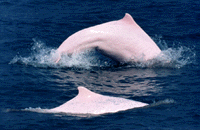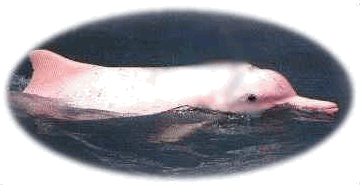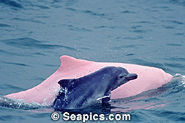|
Scientific Name: Sousa chinesis (Chinese White
Dolphin)
In Hong Kong's scenic western harbor, a population of around
120 Indo-pacific Humpback Dolphins, or Chinese White Dolphins
are fighting to survive against barrage of threats: pollution,
habitat loss, over fishing, and boat traffic.

Two Pink Dolphins Diving

Sousa Chinensis is found from South Africa to North
Australia, but this coloration is unique to Southeast Asia.
As you can see from the picture, these dolphins are pink.
People who have seen both say they're even pinker than the
South American Boto.
What kind of dolphins are these?
These dolphins can be found in geographically isolated populations
from South Africa to Australia and up the Chinese coast to
the Yangtze River. The populations in Southeast Asia are unique
in their coloring: born almost black, they quickly change
to light grey, then slowly become white or pink as the grey
coloration recedes.

Pink Dolphins are born gray
Where are they?
The Chinese White Dolphin is almost always found near coastlines,
and usually near a major river mouth. The Pearl River provides
the brackish (estuarine) water favored by this population.
Young males may wander quite far from the group, but the population
as a whole is unlikely to move to another location, no matter
how degraded the environment becomes.
This population is usually found to the north of Lantau Island,
and occasionally to the southwest, near the Soko Islands,
and the southeast, near Peng Chau. The western, northern,
and southern extents of their range are not known, though
pink dolphins have been sighted around Macau.
How many dolphins are there?
Estimates range from fewer than 100 to around 150.
Why is the pink dolphin pink?
Not a lot is known about the dolphin's coloring because of
their remoteness and rarity. It has been speculated they are
pink for the same reason as pink flamingos. Like the dolphin,
these marshland birds are not born pink but turn this color
as they get older. A red pigment found in the muscle tissue
of the crabs and shellfish theyear colors the flamingos. The
colored molecule is not digested, yet is still absorbed in
the birds' gizzard and accumulates in the shafts of the birds'
growing feathers. Although this pigment is not visible in
the raw meat of crustatia, it is the same pigment, which causes
a prawn to turn pink when cooked.
More information
>
|
